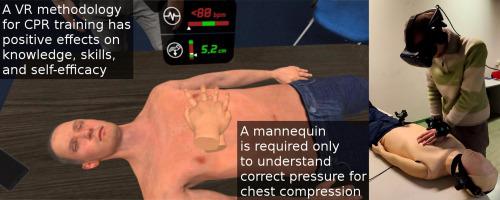Journal of Biomedical informatics ( IF 4.5 ) Pub Date : 2020-10-08 , DOI: 10.1016/j.jbi.2020.103590 Fabio Buttussi 1 , Luca Chittaro 2 , Francesca Valent 3

|
Background
Cardiopulmonary resuscitation (CPR) is an emergency procedure that can increase survival after a cardiac arrest. Performing CPR effectively requires both procedural knowledge and manual skills. Traditional CPR training methodology includes lessons led by instructors and supervised practice on mannequins, thus requiring considerable resources.
Objective
This paper proposes a new methodology for low-cost CPR training based on virtual reality (VR) with and without the addition of a physical mannequin. Moreover, it describes an experimental evaluation of the methodology that assessed gain in manual skills during training, transfer of procedural knowledge and manual skills in a final assessment, and changes in self-efficacy with three measurements over time (pre-training, post-training, and post-assessment).
Methods
We implemented a VR application that supports the proposed methodology, and can thus be used with or without a mannequin. The experimental evaluation involved 30 participants who tried CPR in VR twice, performing two repetitions of 30 chest compressions per trial. Half participants tried the VR application with the mannequin and half without it. Final assessment required all participants to perform CPR on the mannequin without the assistance of VR. To assess self-efficacy, participants filled in a questionnaire at the three times of measurement.
Results
Mixed-design ANOVAs showed effects of repetition, effects of group, or interaction between the two variables on manual skills assessed during training. In the final assessment, participants in both groups correctly remembered most of the steps of the procedure. ANOVAs revealed differences between the two groups only in pressure-related skills (better with mannequin) and in the number of wrong steps added to the procedure (better without mannequin). Mixed-design ANOVA showed a self-efficacy increase in both groups after training, which was maintained after final assessment.
Conclusions
The proposed VR methodology for CPR training has a positive effect on procedural knowledge, manual skills, and self-efficacy, with as well as without the physical mannequin. Trials on a mannequin are required to understand the correct pressure for chest compression. This supports the adoption of the proposed VR methodology to reduce instructor and mannequin time required to teach CPR to trainees.
中文翻译:

带有和不带有人体模型的心肺复苏训练的虚拟现实方法
背景
心肺复苏(CPR)是一种紧急程序,可以增加心脏骤停后的生存率。有效地执行心肺复苏术需要程序知识和手工技能。传统的心肺复苏术培训方法包括讲师讲授的课程和人体模型的监督练习,因此需要大量资源。
目的
本文提出了一种基于虚拟现实(VR)的低成本CPR培训的新方法,该方法带有或不带有物理人体模型。此外,它还描述了一种方法的实验评估,该方法评估了培训期间的手动技能获得,最终评估中的程序知识和手动技能的转移以及随着时间推移进行的三项测量(培训前,培训后)的自我效能的变化。以及评估后)。
方法
我们实现了一个支持所建议方法的VR应用程序,因此可以与或不与人体模型一起使用。实验评估涉及30位参与者,他们两次在VR中尝试了CPR,并且每次重复两次进行30次胸部按压。一半的参与者尝试了带有人体模型的VR应用程序,一半没有参与者。最终评估要求所有参与者在不借助VR的情况下对人体模型执行CPR。为了评估自我效能,参与者在测量的3次中填写了一份问卷。
结果
混合设计的方差分析显示了重复的影响,小组的影响或两个变量之间的相互作用对培训期间评估的手动技能的影响。在最终评估中,两组参与者都正确记住了该过程的大多数步骤。方差分析显示两组之间的区别仅在于压力相关技能(使用人体模型更好)和添加到该程序的错误步骤数量(不使用人体模型更好)上的差异。混合设计的方差分析显示训练后两组的自我效能都有所提高,经最终评估后仍保持。
结论
拟议的用于心肺复苏术训练的VR方法在没有人体模型的情况下对程序知识,手工技能和自我效能有积极的影响。需要进行人体模型试验以了解正确的胸部按压压力。这支持采用拟议的VR方法来减少向学员传授CPR所需的教练和人体模型时间。



























 京公网安备 11010802027423号
京公网安备 11010802027423号